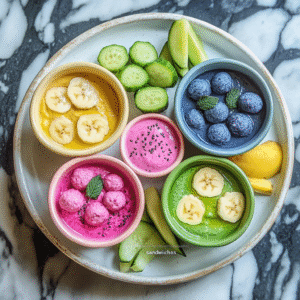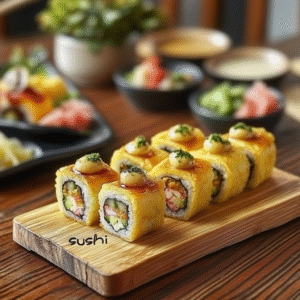1. Introduction: Fueling Growth with Plant-Powered Fun
2. Nutritional Foundations: What Growing Kids Need
2.1 Daily Calorie & Macronutrient Targets
Ages 4–8: 1 200–1 400 kcal/day
Ages 9–13: 1 600–2 200 kcal/day
Carbohydrates (45–65 %): Primary fuel for cognitive tasks and play; choose whole-grain oats, sweet potatoes, fruits.
Protein (10–30 %): Essential for muscle and organ development; sources include beans, lentils, nut butters, tofu.
Fats (25–35 %): Support hormone production, nerve insulation, and absorption of fat-soluble vitamins; select avocado, seeds, olives.
2.2 Key Micronutrients & Fiber
Iron: Supports attention and cognitive performance; found in lentils, spinach, fortified cereals.
Calcium & Vitamin D: Critical for bone growth; sources include fortified plant milks (soy, oat), tofu, and leafy greens.
Vitamin B12: Necessary for nerve development; obtained from fortified nutritional yeast or spreads.
Fiber (14 g per 1 000 kcal): Promotes gut health and satiety; sourced from fruits, vegetables, legumes, and whole grains.
2.3 Balancing Glycemic Load
Pair moderate-GI carbohydrates (e.g., oats, apples) with protein and healthy fats (e.g., hummus, nut butters) to prevent sharp blood-sugar spikes that can lead to hyperactivity and energy crashes. Aim for a 2 : 1 carbohydrate-to-protein ratio in snack compositions (for example, 20 g carbs paired with 10 g protein) to sustain energy for learning and play.
3. Top 5 Pre-School Vegan Snack Ideas
Perfect for morning fuel before preschool or daycare, these five snacks are easy to hold, eat, and clean up, delivering ~150 kcal each with balanced macros.
3.1 Banana-Oat Energy Bites
Macro Breakdown per Bite: 11 g carbs | 3 g protein | 3 g fat
Ingredients:
1 cup rolled oats
1 ripe banana, mashed
2 Tbsp sunflower seed butter
1 Tbsp ground flaxseed
1 tsp maple syrup (optional)
Method: In a medium bowl, combine mashed banana, oats, sunflower butter, flaxseed, and maple syrup. Mix thoroughly, then roll into 1″ balls. Chill on a parchment-lined tray for 30 minutes. Store in an airtight container in the fridge for up to 5 days.
3.2 Mini Hummus & Veggie Cups
Macro Breakdown per Cup: 20 g carbs | 8 g protein | 7 g fat
Ingredients:
1 cup canned chickpeas, drained and rinsed
2 Tbsp tahini
1 Tbsp lemon juice
Pinch of sea salt
Carrot sticks and cucumber spears
Method: Blend chickpeas, tahini, lemon juice, and salt to a smooth hummus. Spoon 2 Tbsp into 4 oz silicone or glass cups. Insert vegetable sticks upright. These cups can be prepared the night before and stored refrigerated up to 24 hours.
3.3 Apple “Sandwich” Slices
Macro Breakdown per Sandwich: 15 g carbs | 2 g protein | 5 g fat
Ingredients:
1 medium apple, cored and sliced into ½″ rounds
2 Tbsp almond or sunflower seed butter
Pinch of cinnamon
Method: Spread seed butter on one apple round, top with another to form a “sandwich,” and dust with cinnamon. Slice into halves for smaller hands.
3.4 Blueberry Chia Pudding Cups
Macro Breakdown per ½ cup: 15 g carbs | 4 g protein | 5 g fat
Ingredients:
1 cup unsweetened plant milk (soy or almond)
3 Tbsp chia seeds
½ tsp vanilla extract
½ cup fresh or frozen blueberries
Method: Whisk plant milk, chia seeds, and vanilla in a jar; refrigerate for at least 2 hours or overnight until thick. Top with blueberries before serving.
3.5 Rainbow Fruit Skewers
Macro Breakdown per Skewer: 12 g carbs | 1 g protein | 0.5 g fat
Ingredients: Strawberries, mango, kiwi, green grapes, blueberries; short bamboo skewers.
Method: Thread fruits in rainbow order. Serve with a side of plain vegan yogurt for dipping. These skewers encourage kids to try new fruits in a visually appealing format.

4. Top 5 After-School Vegan Snack Ideas
After a full day of learning or activity, children need more substantial snacks to restore energy, support muscle recovery, and maintain concentration until dinner.
4.1 Sweet Potato Toast with Avocado
Macro Breakdown per 3 Slices: 20 g carbs | 5 g protein | 10 g fat
Ingredients:
1 large sweet potato, cut into ½″ slices
1 ripe avocado
Juice of ½ a lime
1 Tbsp hemp seeds
Method: Toast sweet potato slices in a toaster or oven until tender (about 8–10 minutes at 375 °F). Mash avocado with lime juice and spread on each slice. Sprinkle with hemp seeds for added protein and omega-3.
4.2 PB&J Veggie “Sushi” Rolls
Macro Breakdown per Serving (3 rolls): 25 g carbs | 8 g protein | 9 g fat
Ingredients:
Whole-grain tortilla
2 Tbsp peanut butter
1 Tbsp fruit jam
Thin cucumber strips
Method: Spread peanut butter and jam evenly on a tortilla. Lay cucumber strips across the top, roll tightly, and slice into 1″ “sushi” pieces.
4.3 Edamame & Corn Salad Cups
Macro Breakdown per Cup: 18 g carbs | 10 g protein | 5 g fat
Ingredients:
1 cup frozen shelled edamame, thawed
½ cup frozen corn, thawed
1 Tbsp olive oil
Chopped fresh parsley and a squeeze of lemon
Method: Toss all ingredients together and divide into small cups. This protein-and-fiber-rich snack keeps kids fueled for homework or play.
4.4 DIY Trail Mix Snack Bags
Macro Breakdown per ¼ Cup: 12 g carbs | 6 g protein | 8 g fat
Ingredients: Equal parts pumpkin seeds, sunflower seeds, dried cranberries, whole-grain cereal puffs.
Method: Mix ingredients and portion into reusable silicone snack bags. Portion control ensures balanced macros without overindulgence.
4.5 Yogurt Parfait Cones
Macro Breakdown per Cone: 25 g carbs | 8 g protein | 7 g fat
Ingredients:
Mini waffle cones
¾ cup vegan coconut or soy yogurt
¼ cup granola
¼ cup mixed berries
Method: Layer yogurt, granola, and berries in cones. These hand-held parfaits combine textures and macros in a fun format.

5. Creative Presentation & Kid Engagement
Turning snack time into playtime encourages adventurous eating and skill development.
5.1 Veggie Critter Cups
Repurpose silicone muffin liners as “flower pots,” fill with hummus “soil,” and insert carrot “trees,” cucumber “logs,” and olive “ladybugs.” Children can name their garden creatures before digging in, reinforcing imaginative play and fine motor skills.
5.2 Cookie-Cutter Creations
Use cookie cutters to shape sandwiches, tortillas, rice cakes, or fruit slices into stars, hearts, dinosaurs, or letters. Provide edible markers (food-safe pens) and seed “sprinkles” so kids can decorate their own creations, fostering creativity and ownership.
5.3 Kabob Rainbows
Thread colorful fruits or vegetables onto short bamboo or silicone skewers in rainbow order. This visual appeal not only engages color-learning but encourages consumption of multiple fruit and veggie servings in a single snack.

6. Meal Prep, Storage & Food Safety
Efficient meal prep and safe storage methods keep snacks fresh, accessible, and microbiologically safe.
6.1 Weekly Batch Prep
Dedicate 1–2 hours weekly to bake muffins, roll energy bites, and wash/portion produce. Use clear, labeled glass containers and stackable silicone pouches to streamline morning routines.
6.2 Refrigeration & Freezing
Refrigerate perishable items at or below 4 °C for up to 48 hours. For longer storage, flash-freeze muffins, energy bites, and veggie cups on a tray for 1 hour, then transfer to freezer bags. Thaw overnight in snack bags so items are ready by morning.
6.3 Food-Safety Best Practices
Teach children and caregivers proper hand-washing before prep and eating.
Keep dips and puddings in sealed containers; discard after 24 hours.
Sanitize cutting boards and utensils between raw veggies and other ingredients to prevent cross-contamination .
7. Allergen Management & Label Reading
Many vegan snacks exclude dairy and eggs but may contain tree nuts, soy, or gluten.
7.1 Reading Ingredient Labels
Carefully check packaged-ingredient labels for allergens. In nut-free settings, replace almond or peanut butter with sunflower or pumpkin seed butter. For gluten-free requirements, use certified gluten-free oats, crackers, and flours.
7.2 Preventing Cross-Contact
Assign dedicated prep tools and areas for allergen-free items. Color-code containers and utensils to avoid mix-ups in busy household kitchens.
7.3 Internal Link for Basics
Stock your pantry with versatile staples—beans, oats, seeds, dried fruits—by reviewing our Vegan Pantry Essentials guide for quick snack assembly ideas.
8. Involving Kids in the Kitchen
Hands-on cooking fosters confidence, fine motor skills, and willingness to taste new foods.
8.1 Age-Appropriate Tasks
Ages 2–4: Washing produce, mashing bananas, stirring mixtures.
Ages 5–7: Scooping and measuring dry ingredients, rolling energy bites.
Ages 8+: Safe chopping with plastic knives, threading kabobs, cookie-cutter shaping.
8.2 Kitchen Safety Education
Teach children to:
Wash hands for 20 seconds before cooking.
Use oven mitts and stay clear of hot surfaces.
Clean up spills immediately to prevent slips.
9. External Resources & Video Tutorials
For additional authoritative guidance, explore the USDA’s official MyPlate for Kids resources, which offer interactive games, tip sheets, and balanced snack ideas for children MyPlate. For a step-by-step visual demonstration, watch the viral YouTube video “10 Fun Vegan Snacks for Kids” by Pick Up Limes (750K+ views), showcasing creative assembly techniques and presentation tips to make snack time engaging and nutritious.
10. Budget & Sustainability Tips
10.1 Cost-Effective Ingredients
Buy oats, beans, and seeds in bulk to reduce cost to <$0.30 per serving.
Use seasonal produce—which is often cheaper and more nutrient-dense—for fruit skewers and veggie cups.
10.2 Zero-Waste Practices
Replace single-use plastic wrap with beeswax wraps or silicone pouches.
Compost fruit and veggie scraps.
Transform stale bread into breadcrumbs for savory snacks or DIY granola.
10.3 Community Engagement
Host snack-swap events with friends or neighbors—exchange batches of different homemade snacks to introduce variety and foster community support.
11. Beverage Pairings & Hydration Strategies
Staying properly hydrated is as vital as choosing the right snacks. Children’s thirst cues can be unpredictable—pairing snacks with appealing, nutrient-rich beverages ensures they receive both fluids and complementary nutrients.
11.1 Why Hydration Matters for Growing Kids
Adequate fluid intake supports digestion, nutrient transport, temperature regulation, and cognitive performance. Even mild dehydration can impair concentration and energy levels during learning and play .
11.2 Balanced Beverage Choices
Plain Water: The best default choice. Offer it chilled or at room temperature, and enhance appeal with fruit slices or fresh herbs (e.g., cucumber–mint or strawberry–basil).
Fortified Plant Milks: Unsweetened soy or oat milk adds calcium, vitamin D, and 4–6 g of plant protein per ½-cup serving—perfect alongside protein-rich snacks.
Diluted 100% Fruit or Vegetable Juices: Mix one part juice with three parts water to boost flavor and vitamin C without excessive sugars. Serve in small cups to control portions.
11.3 DIY Nutrient-Rich Drink Ideas
Cucumber–Mint Spa Water: Infuse a pitcher of water with thin cucumber slices and fresh mint leaves for at least 30 minutes.
Berry Hibiscus Cooler: Steep hibiscus tea, chill, then stir in mashed berries and a squeeze of lime for natural sweetness and antioxidants.
Green Smoothie Sipper: Blend ½ cup spinach, 1 cup water or plant milk, ½ banana, and a handful of pineapple chunks; strain if needed for younger children to ensure a smooth consistency.
11.4 Matching Drinks to Snacks
Pair cool, lightly flavored spa water with crunchy snacks (energy bites, crackers) to facilitate easy swallowing and encourage sipping.
Serve lukewarm herbal teas (chamomile or rooibos) alongside dry cookies or crackers to prevent choking risks and add soothing warmth.
Offer a ½-cup of fortified plant milk with protein-dense snacks (hummus cups, yogurt parfait cones) to round out macronutrient profiles and support growth.
12. Troubleshooting & Expert Tips
Even the best snack plans can encounter hiccups. Use these strategies to optimize texture, flavor, and variety—and keep kids excited about healthy eating.
12.1 Preventing Common Pitfalls
Soggy Veggie Cups: Drain dips thoroughly and line cups with paper or silicone liners to wick moisture away from vegetables.
Dry or Crumbly Bites: If energy bites or muffins lack moisture, increase the binder (sunflower seed butter or mashed banana) by 1–2 tablespoons or add an extra 1–2 tablespoons of plant milk; always chill before serving.
Overly Sweet Treats: Reduce added syrups by 25 % when using very ripe fruits; add a pinch of sea salt or blackstrap molasses to balance sweetness and deepen flavor.
12.2 Enhancing Flavor & Texture
Umami & Savory Boosts: Stir a teaspoon of nutritional yeast or a dash of garlic powder into chickpea-based dips for richer, more complex flavors.
Tenderness in Baked Snacks: Fold in 1–2 tablespoons of applesauce or mashed pumpkin into muffin and cookie batters to increase moisture and create a softer crumb.
Preserving Crunch: Add toasted seeds or chopped nuts immediately before serving to maintain a satisfying crunch in granolas and trail mixes.
12.3 Storage Longevity Tips
Room-Temperature Storage: Keep baked goods in airtight glass containers for up to 48 hours at room temperature.
Refrigeration: Store perishable items (puddings, hummus) in sealed containers and consume within 24 hours to ensure safety.
Freezing: Flash-freeze fully cooled muffins, energy bites, and cookie dough balls on a tray for 1 hour, then transfer to freezer bags; thaw at room temperature or warm briefly in a low-heat oven when ready to eat.
First-In, First-Out: Label containers with dates and rotate older items to the front to minimize waste and maximize freshness.
12.4 Maintaining Variety & Engagement
Flavor Rotations: Change up spices (cinnamon, cardamom, cocoa), extracts (vanilla, citrus), and mix-ins (dried fruit, seeds, shredded coconut) each week.
Themed Snack Weeks: Plan “Rainbow Rainbow,” “Crunchy Seed,” or “Berry Blast” weeks with corresponding snack themes to spark excitement.
Child-Led Innovation: Encourage kids to propose and name new snack combinations, offering a controlled selection of ingredients for them to mix and match under supervision.
Implementing these expert tips ensures that your Vegan Snacks for Kids station remains fresh, flavorful, and fun—fostering healthy habits that last a lifetime.
13. Community & School Engagement
Encourage local preschools or PTA groups to host “healthy snack” demos or label-reading workshops. Provide printed recipe cards and allergy guides to support educators and parents in offering balanced vegan snacks.
14. Conclusion & Next Steps
You now have a comprehensive, 3 000-word toolkit of Vegan Snacks for Kids—ten balanced recipes, creative presentation ideas, meal-prep strategies, safety protocols, and budget-friendly sustainability tips.
Rotate Two New Recipes Weekly to maintain excitement and variety.
Implement a Weekly Snack-Prep Routine to streamline busy mornings.
Involve Children in Prep and Presentation to foster ownership and adventurous eating.
After exploring so many delicious plant-based recipes, why not dive deeper into the science behind your meals? This comprehensive online course features over 60 video lessons (40 hours total) and even a certificate upon completion. It’s perfect for planning balanced menus, understanding essential nutrients, and taking your vegan knowledge to the next level.
Discover the full course here.